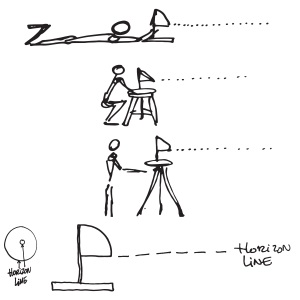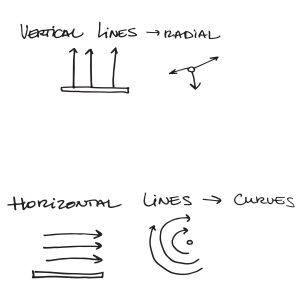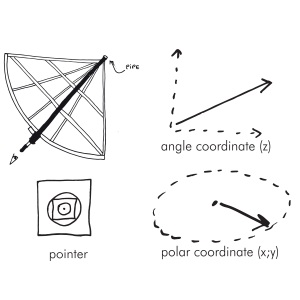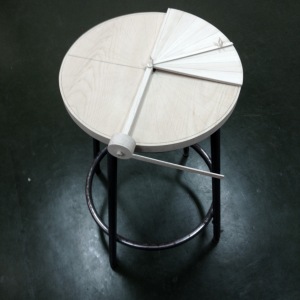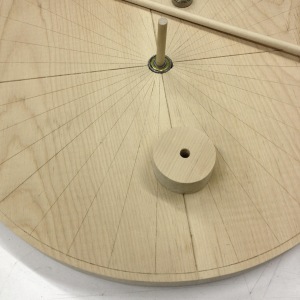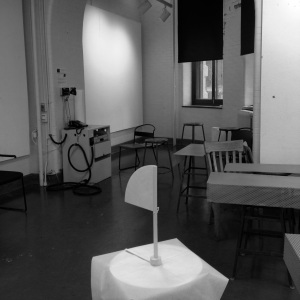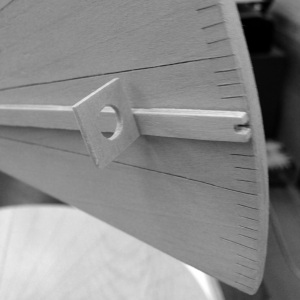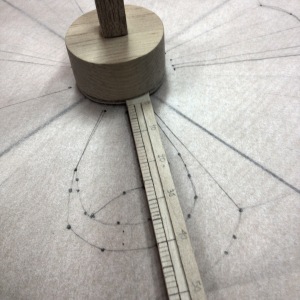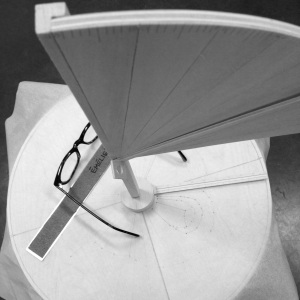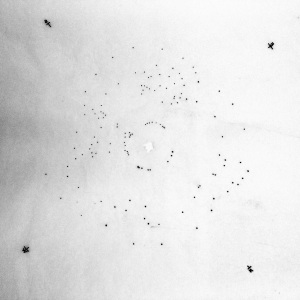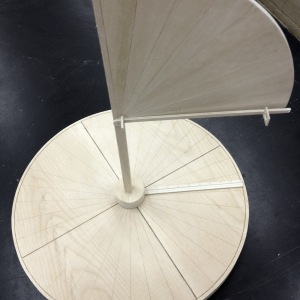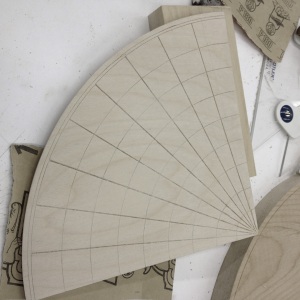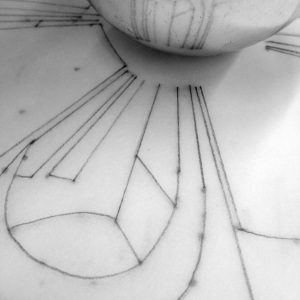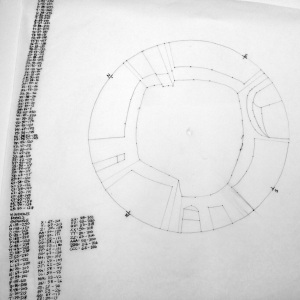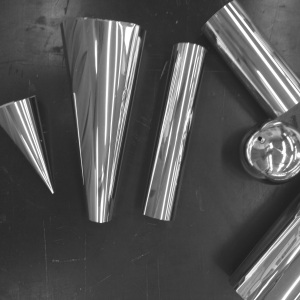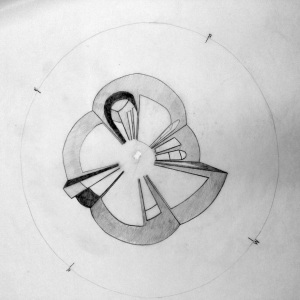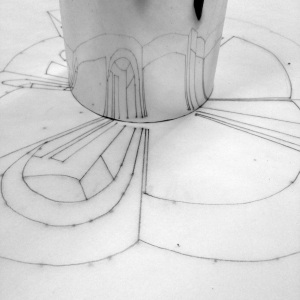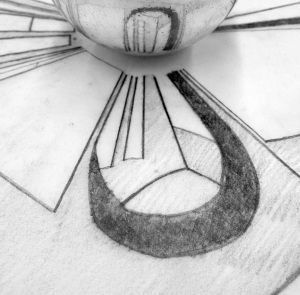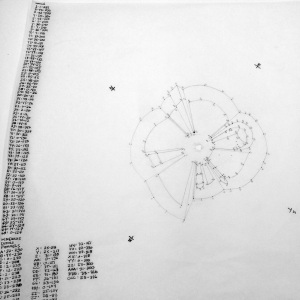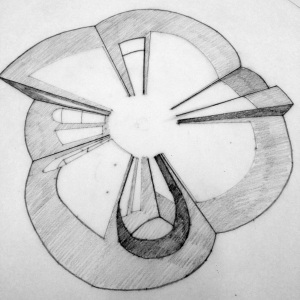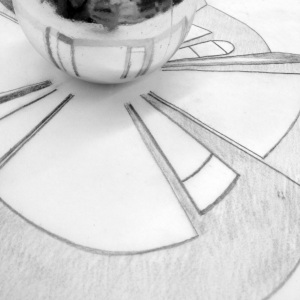L’objet réalisé s’inspire d’abord des recherches précédentes sur le quadrant, la projection orthographique, ainsi que le torquetum. Il est également une hybridation entre les projets antérieurs du cours, soit l’astrolabe pour le calcul de la position des astres ainsi que la carte de Rome pour la représentation par coordonnées polaires.
L’instrument consiste à faire un relevé d’un espace, d’un paysage ou d’astres sur 360 degrés en prenant en note des coordonnées de points. Dans l’exemple suivant, le relevé a été fait dans la salle 102 du bâtiment Macdonald-Harrington. Le dessin alors obtenu transforme la réalité en la déformant de manière à ce que toute ligne horizontale devienne un arc de cercle et une ligne verticale devienne une ligne axiale. Une base en bois, horizontale, est divisée en 360 degrés et est alignée de préférence avec les points cardinaux. Sur cette base, un mat rotatif soutient un quadrant de 90 degrés, avec un pointeur qui peut ainsi déterminer l’angle de vision d’un point déterminé. Cet angle calculé, on se réfère à une règle graduée sur la base horizontale pour noter le point en question. Comme cette règle suit exactement la direction du pointeur, elle détermine la coordonnée polaire du point.
Ces deux «coordonnées» peuvent également être notées pour permettre au lecteur de construire/imprimer lui-même sa propre image comme le système utilisé par Alberti pour la carte de Rome. La hauteur à laquelle l’instrument est placé détermine la hauteur de l’horizon, soit le degré zéro. Donc, il n’est pas possible de prendre le relevé de ce qu’il y a plus bas que cet horizon sauf en baissant l’instrument. Autrement, une solution envisageable serait de calculer les angles avec un demi cercle au lieu d’un quadrant, et donc de graduer la règle sur 180 degrés plutôt que 90. Une des itérations également possible en terme de représentation est d’inverser l’horizon sur le dessin pour la périphérie du cercle plutôt qu’en son centre.
Comme le dessin final obtenu à partir du nouvel instrument est expérimental et inattendu, l’interprétation du dessin l’est également. L’hypothèse formulée fut de rapprocher ce type de déformation à celles obtenues pour créer des anamorphoses avec des miroirs. Différentes formes et dimensions de miroirs (cylindriques, coniques et sphériques) ont été reproduits pour “lire” le dessin et mieux comprendre ce type de relevé. Comme l’instrument est un quart de cercle rotationnant sur 360 degrés, il est logique que le miroir sphérique soit celui qui reflète le dessin en corrigeant sa déformation.
Une attention particulière a également été porté au design et à la conception de l’objet en respectant l’idée d’artisanat et d’utilisation d’outils de mesure plus rudimentaires. Les proportions ont aussi été calculées, en plus de respecter les formes géométriques pures telles le cercle et le carré. Le dessin obtenu est inspiré de la technique de cartographie du ciel étoilé, mais pour dessiner l’univers, représenter 360 degrés sur une surface. La technique systématique et rigoureuse du relevé y confère une certaine subjectivité. Cependant, il n’y a pas de précision à ce type de dessin, il est difficilement calculable et c’est une vision impossible. Expérimentale, cette “perspective sphérique” est également une représentation symbolique de l’univers, le cercle étant traditionnellement réservée aux cieux, à la perfection, l’absolu, l’infini, le divin.
* * *
The object made is first based on the previous research on the quadrant, the orthographic projection, and the torquetum. But it is also a hybrid of earlier projects of the course; the astrolabe for the calculation of the position of the stars and the map of Rome for the representation by polar coordinates.
The instrument takes a survey of a space, a landscape or even stars, on 360 degrees by drawing the coordinate points. The drawing is then transformed by deforming reality so horizontal lines become circular arcs and vertical lines become axial lines. A horizontal wooden base is divided into 360 degrees and is preferably aligned with the cardinals. On this basis, a rotary mat supports a 90 degrees quadrant, with a pointer that can determine the angle of view of a given point. This angle calculated, it refers to a ruler on the horizontal base to draw the calculated point. As this rule follows exactly the direction of the pointer, it determines the polar coordinate of the point.
These two “coordinates” can also be recorded to enable the reader to build / print itself its own image as the system used by Alberti’s map of Rome. The height at which the instrument is situated determines the height of the horizon, or the zero degree. Therefore, it is not possible to survey below this horizon except by lowering the instrument. Otherwise, a possible solution would be to calculate the angles with a half circle instead of a quadrant, and thus grade the rule with 180 degrees rather than 90. One of iterations also possible in representation, would be to reverse the horizon of the drawing at the periphery of the circle instead of its center.
Because the final obtained drawing is experimental and unexpected, his interpretation is also unexpected. The hypothesis was to link this type of deformation to those obtained with mirrored anamorphosis. Different shapes and sizes of mirrors (cylindrical, conical and spherical) were reproduced to “read” the drawing and understand this type of survey. Because the instrument is a quarter circle rotating on 360 degrees, it is logical that the spherical mirror is the good reflection which correct the deformation.
A particular care was paid to the design and the realisation of the object, by respecting the idea of craftsmanship and use of more rudimentary measurement tools in order to fully understand it. The proportions were also calculated, in addition to meet the pure geometric shapes such as the circle and the square. The drawings obtained were inspired by the cartography technique of the heavens, but in that case to draw from the universe, on 360 degrees, graphically transferred on a surface. The systematic and rigorous technique confers a subjectivity. However, there is no precision in that drawing, it is difficult to calculate and it is an impossible vision. Experimental, this “spherical perspective” is also a symbolic representation of the universe, the circle traditionally reserved for heaven, to perfection, the absolute, the infinite, the divine.
Émélie DT
